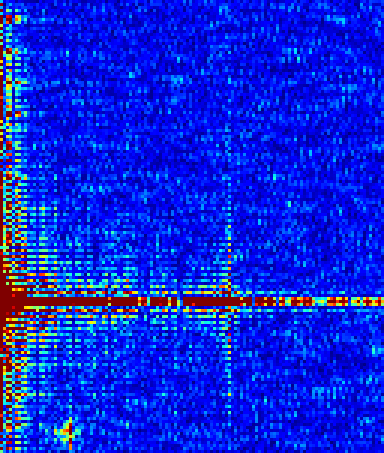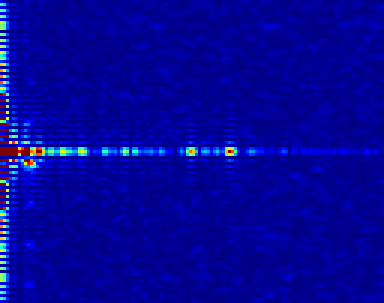This is a page on my year-long thesis project from my final year of electrical engineering at the University of Queensland. The topic was 'Passive Radar Detection'. The focus shifted a bit throughout the project, ending up on algorithms, clutter suppression, and target acquisition and tracking. It was heaps of fun because I got to go outside and hunt down good locations for viewing flight paths, and it was really cool that I was able to detect aircraft without transmitting any signals. The ultimate triumph of being able to sit in my room, watching my personal radar detect aircraft flying by in real-time was a highlight of my studying career.
The old version of this project can be found on this page.
Demonstration
Preliminary results
These are explained in the next section.
This is a detection of an aeroplane that flew over my antenna during my sixth test. After all the initial noise disappears, you can see a little dot heading up and arcing to the right. That's the aeroplane. Click on the animation to view a version that you can zoom in on.
This is a detection of a helicopter that flew past my antenna during my first test. I made this gif with a slower frame rate to make it clear. The little dot moving through the horizontal line and upwards is the helicopter. Click on the animation to view a version that you can zoom in on.
How do I interpret these results?
Think of it as a plot, or a graph. The y-axis is Doppler shift, and the x-axis is sample delay. The x-axis tells us how far away an object is, and the y-axis tells us whether it is approaching or moving away from the antenna, along with its relative velocity.
So for example, in the aeroplane detection, it gets a bit noisy at the start, but at the end, we see a noticeable dot fly up and arc a bit to the right. This means that it's moving away from the antenna by moving up the y-axis, and it is getting further away by its slow arc parallel to the x-axis.
The constant horizontal line that you see is an artefact of the processing calculations. The next stage of the thesis is to try to remove that constant horizontal line and all the other noise, by techniques called 'clutter cancellation'.
What is passive radar?
This probably should be addressed earlier in the page, but I just think the results look so cool that they have to go first.
In active radar, an antenna basically transmits some electromagnetic waves in a diredction, and then they reflect off objects in the path of transmission, which end up being received back at the original antenna that transmitted them. Then one can perform some processing to discern relative velocities and ranges of targets. I'm sure we've all seen radar in movies with little moving dots going all around some screen.
The difference with passive radar is that a user doesn't transmit anything. Passive radar utilises electromagnetic waves that are already in the air, such as digital TV, digital radio, FM radio, satellite signals, WiFi, and the list goes on. This is what brings on the word 'passive', our little antenna just sits there, receiving, not actively transmitting anything. Often, transmitters can be large, heavy, and require a lot of power to work, whereas only operating a receiver can be very lightweight and physically small, especially given the advent and constant improvement of software defined radios. My current equipment is shown below, to demonstrate how cheaply and easily one could perform passive radar.
However, some downsides consist of the fact that you're at the mercy of what is currently being transmitted in an area, and the physical environment can change the nature of what you're receiving quite a bit. Despite that, many of these signals such as satellite and digital are ubiquitous in many geographical areas, and they have good characteristics for passive radar, making passive radar research an interesting and potentially useful undertaking.
How did it all end up?
I ended up making a passive radar system that could perform clutter suppression, target acquisition and tracking, all in real-time. I then won the thesis prize for the best microwave, photonics and communications project.
In order to hit real-time, I had to include GPU computing, which I hadn't done before. It was a good learning experience, and I now feel more comfortable with using NVIDIA's CUDA.
The thesis ended up being a hobby that I would do in my spare time, because it was so much fun. I encourage all students to try to find a thesis topic that they will really enjoy, as that made all of the difference for me.
Equipment and some files
-LDPA antenna
-RTL-SDR dongle
-GTX950 graphics card
-16GB RAM
The processor and other things don't particularly matter too much.
For those who are trying to design their own passive radar system, here is a recording of an aircraft flying by my system. It starts at a very close path delay (less than 10 samples, if I remember), and a slight negative Doppler shift. It then arcs out, slowly increasing in path delay, and increasing its negative Doppler shift. It's just raw IQ samples in binary form. The format is [I byte_0][Q byte_0][I byte_1][Q byte_1]... etc. The sampling rate was 2.048 MS/s, and the centre frequency was about 202.93 MHz. If you can see the target with your system, then it works! Here's a gif of what it may look like. Doppler shift is on the vertical axis, from -75Hz at the top, down to +75Hz, and path delay is on the horizontal axis, from about 0 to 100 samples. Good luck! Send me any questions you have.
Here's the poster that I presented my project with.

